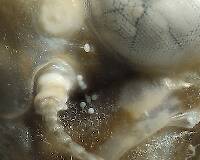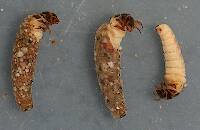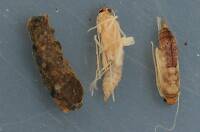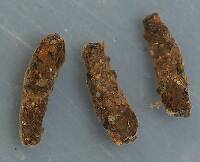
Blue-winged Olives
Baetis
Tiny Baetis mayflies are perhaps the most commonly encountered and imitated by anglers on all American trout streams due to their great abundance, widespread distribution, and trout-friendly emergence habits.
Featured on the forum

With a bit of help from the microscope, this specimen keys clearly and unsurprisingly to Hydropsyche.

Troutnut is a project started in 2003 by salmonid ecologist Jason "Troutnut" Neuswanger to help anglers and
fly tyers unabashedly embrace the entomological side of the sport. Learn more about Troutnut or
support the project for an enhanced experience here.
Konchu on Aug 20, 2007August 20th, 2007, 5:15 am EDT
Here is the abstract (a special kind of summary) from some recent mayfly/trout scholarship. I thought many of you might find this interesting or helpful. I don't have the paper yet.
Abstract: Oviposition behavior of insects has associated fitness costs related to the probability that females survive to oviposit. During summer 2003, we observed the oviposition behavior and compared the mortality rates of females of 17 mayfly species in one western Colorado watershed. We dissected adult females collected on terrestrial sticky traps, in drift nets submerged in streams, and in stomachs of brook trout to determine whether the mayflies had oviposited before capture, drowning, or consumption. Females oviposited by either splashing on the water surface releasing all their eggs (splashers), dropping their eggs from the air (bombers), dipping their abdomens multiple times releasing a few eggs at a time (dippers), landing on rocks and ovipositing on the undersides (landers), or floating downstream while releasing their eggs (floaters). Almost 100% of lander and 50% of dipper females had not oviposited when captured on sticky traps, increasing their vulnerability to preoviposition mortality by aerial predators compared to mayflies with other behaviors. In contrast, most females had laid their eggs before drowning or being eaten by a fish (50-90%). However, groups with oviposition behaviors most exposed to the water surface (floaters, then splashers, dippers, and landers) were more vulnerable to drowning before completing oviposition. In addition, splashers and floaters were most vulnerable to predation by brook trout before ovipositing. These data suggest that fitness costs associated with preoviposition mortality may be considerable depending on mayfly oviposition behavior. Furthermore, previously demonstrated benefits of low predation rates on eggs of lander species may be offset in part by costs to female survival.
Encalada AC, Peckarsky BL. 2007. BEHAVIORAL ECOLOGY AND SOCIOBIOLOGY 61 (9): 1437-1448.
Abstract: Oviposition behavior of insects has associated fitness costs related to the probability that females survive to oviposit. During summer 2003, we observed the oviposition behavior and compared the mortality rates of females of 17 mayfly species in one western Colorado watershed. We dissected adult females collected on terrestrial sticky traps, in drift nets submerged in streams, and in stomachs of brook trout to determine whether the mayflies had oviposited before capture, drowning, or consumption. Females oviposited by either splashing on the water surface releasing all their eggs (splashers), dropping their eggs from the air (bombers), dipping their abdomens multiple times releasing a few eggs at a time (dippers), landing on rocks and ovipositing on the undersides (landers), or floating downstream while releasing their eggs (floaters). Almost 100% of lander and 50% of dipper females had not oviposited when captured on sticky traps, increasing their vulnerability to preoviposition mortality by aerial predators compared to mayflies with other behaviors. In contrast, most females had laid their eggs before drowning or being eaten by a fish (50-90%). However, groups with oviposition behaviors most exposed to the water surface (floaters, then splashers, dippers, and landers) were more vulnerable to drowning before completing oviposition. In addition, splashers and floaters were most vulnerable to predation by brook trout before ovipositing. These data suggest that fitness costs associated with preoviposition mortality may be considerable depending on mayfly oviposition behavior. Furthermore, previously demonstrated benefits of low predation rates on eggs of lander species may be offset in part by costs to female survival.
Encalada AC, Peckarsky BL. 2007. BEHAVIORAL ECOLOGY AND SOCIOBIOLOGY 61 (9): 1437-1448.
Gene
Posts: 107
Posts: 107
Gene on Aug 20, 2007August 20th, 2007, 5:27 am EDT
Gentlemen:
Interesting stuff! However, unless it can be shown that there is a reproductive advantage (quantitatively) than it may be more interesting than relative! In other words, do those female groups with the best methods lay the most eggs and do the most hatch. I believe this part may be a little hard to do. IN evolution there are many traps to fall into. While at first glance this may appear to give some groups a selective advantage it may be also that somethings as we know in evolution "just go along for the ride." These include behaviors and morphology.
tight lines and big rising trout
gene
www.flyfisher.com
Interesting stuff! However, unless it can be shown that there is a reproductive advantage (quantitatively) than it may be more interesting than relative! In other words, do those female groups with the best methods lay the most eggs and do the most hatch. I believe this part may be a little hard to do. IN evolution there are many traps to fall into. While at first glance this may appear to give some groups a selective advantage it may be also that somethings as we know in evolution "just go along for the ride." These include behaviors and morphology.
tight lines and big rising trout
gene
www.flyfisher.com
Wiflyfisher on Aug 20, 2007August 20th, 2007, 5:40 am EDT
Interesting, thank you!
Now all we need to do is determine which mayfly spinners each specie is:
Splashers - splash butt in water to release all the eggs
Bombers - drop eggs from the air while doing a fly-by
Dippers - dip abdomen in water several times releasing some eggs each time
Landers - landing on rocks and ovipositing on the undersides
Floaters - release eggs while floating downstream
I wonder if I could get a grant to spend a whole summer out West on the Henry's Fork studying the reproductive advantages of the various spinner types? It would be tough but I would make the sacrifice!
Jason, you need another datafield for your bug database table. :)
Now all we need to do is determine which mayfly spinners each specie is:
Splashers - splash butt in water to release all the eggs
Bombers - drop eggs from the air while doing a fly-by
Dippers - dip abdomen in water several times releasing some eggs each time
Landers - landing on rocks and ovipositing on the undersides
Floaters - release eggs while floating downstream
I wonder if I could get a grant to spend a whole summer out West on the Henry's Fork studying the reproductive advantages of the various spinner types? It would be tough but I would make the sacrifice!
Jason, you need another datafield for your bug database table. :)
John S.
https://WiFlyFisher.com
https://WiFlyFisher.com
Gene
Posts: 107
Posts: 107
Gene on Aug 20, 2007August 20th, 2007, 8:11 am EDT
Gentlemen:
I will volunteer as a scientist if we do get a grant for such activities. Furthermore, in the scheme of things this appears to be just as important as some of the grants the government gives away! As Robert Traver put it perhaps things equally unimportant but not as much fun.
tight lines and mayfly grants!
gene
www.eugenemacri.com
I will volunteer as a scientist if we do get a grant for such activities. Furthermore, in the scheme of things this appears to be just as important as some of the grants the government gives away! As Robert Traver put it perhaps things equally unimportant but not as much fun.
tight lines and mayfly grants!
gene
www.eugenemacri.com
Quick Reply
Related Discussions
Topic
Replies
Last Reply
1
Jul 22, 2006
by Taxon
by Taxon







